Tapang kalabaw is a Kapampangan delicacy and it is also called “pindang damulag” in their dialect. If you’ve been to Pampangga, you can see many vendor selling this preserved meat. And if you it’s your first time to taste this, you will think it is spoiled already because it is tremendously sour. If you don’t like the very sour taste of those sold in the market, you can make this tapang kalabaw yourself and shorten the curing time, probably, you can cure it for less then a day then cook it or freeze it then cook it anytime you want.
A Taste of Home and Heritage
Growing up in the heart of Pampanga, I was surrounded by the rich culinary traditions that make the region famous. One of the dishes that instantly takes me back to childhood is tapang kalabaw, also known locally as pindang damulag. It’s a dish that, to many Kapampangans, is not just food but a celebration of heritage. My earliest memories of this delicacy come from my ingkung (grandpa), who would often bring home packets of it after visiting the nearby market. The smell alone was enough to fill the house with excitement, as we all knew it would soon be the centerpiece of a hearty meal.
A Delicacy with Deep Roots
Tapang kalabaw might not be as mainstream as pork or beef tapa, but in Pampanga, it’s a revered dish with deep roots. Traditionally, carabao meat was preserved out of necessity. Back in the day, without refrigeration, people had to find ways to extend the life of their meat. By salting and curing it, they could enjoy the meat for days—sometimes weeks—after slaughter. Today, this method has evolved into the delicious jerky-like dish we know and love.
In our home, making this dish was more than just preparing food—it was an event. I remember sitting with my lola as she prepared the meat, her hands expertly sprinkling the curing mixture over each slice. She would explain that the curing process was what gave the meat its distinctive tangy flavor. “The longer it sits, the sourer it gets,” she would say. As a child, I didn’t fully appreciate this, but as I grew older, I realized that it was precisely that sourness that made the dish unique.
Adjusting the Flavor to Your Preference
One thing about tapang kalabaw is that it can be quite polarizing for first-timers. If you’re not used to it, the sharp sourness can be overwhelming. I remember the first time my cousin from Manila tried it. She winced at the initial taste, thinking it had already spoiled! My lolo laughed and explained that the intense tang was all part of the experience. However, he did mention a little secret: if you prefer a milder flavor, you can shorten the curing time.
This tip has served me well over the years. Whenever I introduce this dish to friends who aren’t familiar with its bold flavors, I tweak the curing time. A day or two is usually enough to mellow the sourness while still keeping the distinct Kapampangan essence intact. You can even freeze the cured meat after a day and cook it whenever you’re ready, giving you control over just how sour you want your tapa.
The Perfect Way to Cook and Serve
Cooking tapang kalabaw is a straightforward process, but as with most Filipino dishes, it’s all about the details. My tita, who always had a way of making even the simplest meals extra special, shared with me her method for cooking the jerky. She would start by boiling the meat until it was tender enough to shred. The smell of the slow-cooking meat would fill the kitchen, building anticipation. After boiling, she’d drain the liquid and shred the meat using two forks. This step is crucial—it transforms the cured meat into something that looks a bit like shredded corned beef, ready to be crisped to perfection.
Once shredded, frying it in oil until crispy is where the magic happens. The edges of the meat would turn a beautiful golden brown, adding a satisfying crunch to each bite. Paired with garlic fried rice and a perfectly fried egg, it’s no wonder this dish often found its way onto our breakfast table. And when carabao milk was available, we’d serve it alongside, creating a tapsilog (tapa, sinangag, and itlog) like no other.
The Cultural Significance of Tapang Kalabaw
What many might not realize is that tapang kalabaw is more than just a dish—it’s a reflection of Filipino ingenuity and resourcefulness. Carabaos have been part of the Filipino farming tradition for centuries, often used in the fields to plow rice paddies. But in Pampanga, they are also a part of our culinary history. By preserving the meat through curing, our ancestors were able to make sure nothing went to waste.
It’s also worth noting that in the past, tapang kalabaw was considered a special treat. Not every family had access to carabao meat, and those who did often reserved it for special occasions or to honor guests. Today, while it’s easier to find, especially in markets across Pampanga, it still carries that sense of pride and tradition.
Bringing a Taste of Pampanga to Your Kitchen
For those who may be unfamiliar with tapang kalabaw, it can seem intimidating at first, especially with its intense flavor. But once you’ve tasted it, it’s hard not to appreciate the depth and complexity of this dish. Whether you follow a traditional recipe or tweak it to suit your tastes, you’re not just making food—you’re keeping a piece of Filipino culinary history alive.
In our family, the process of making and sharing this dish has always been a way to connect with our roots. It reminds me of mornings in our old kitchen, where my lola would be busy preparing the day’s meals, and my lolo would proudly bring home fresh meat from the market. Those moments, filled with the sounds and smells of cooking, are what I carry with me every time I prepare this dish.
If you’re looking to try something uniquely Filipino, tapang kalabaw is the perfect dish to start with. Its robust flavors, combined with a little history and family tradition, make it a meal that’s not just filling, but deeply satisfying on a cultural level.
How to Cook Tapang Kalabaw (Carabao Meat Jerky)
Ingredients
- 1 kilo carabao meat the kasim part, sliced into 1/4 inch thick
- 1 Tbsp salt
- 1/2 cup sugar
- 1/4 cups anisado wine
- 1 tsp prague powder
- water for boiling the meat
- cooking oil for frying
Instructions
How to make tapang kalabaw or carabeef jerky:
- Place salt, sugar, anisado wine and prague powder in a bowl and mix well. Put mixture in a salt shaker.
- Sprinkle mixture liberally over each piece of meat, making sure to cover both sides.
- Place meat slices either in an enameled, stainless steel or glass casserole.
- Cover with plastic cling wrap and store in a cool dark place.
- Depending on how sour you want the tapa, allow curing for 2 to 3 days or longer.
- To cook the cured meat, boil in enough water to cover all the pieces until fork tender.
- Drain and throw away the liquid.
- Using 2 forks shred the meat to pieces to look like shredded corned beef.
- Heat oil in a frying pan and fry the carabeef until crisp.
- Serve with fried rice and fried egg. If there is carabao milk available, you can also serve it along your tapsilog (tapa, sinangag and itlog).
Notes
Cooking Tips:
Adjust Curing Time for Your Desired Flavor
The curing time plays a crucial role in determining the flavor of your tapang kalabaw. For a milder, less tangy taste, reduce the curing time to just one or two days. If you prefer the traditional, bold sourness, allow the meat to cure for up to three days or longer.Boil the Meat for Tenderness
Before frying, boil the cured carabao meat until it’s fork-tender to ensure it’s juicy and flavorful. Boiling not only softens the meat but also removes excess salt from the curing process. This step makes shredding the meat easier and enhances the final texture after frying.Shred for Maximum Crispiness
After boiling, shred the meat using two forks to create thin strands that fry more evenly. Shredding increases the surface area, allowing the meat to crisp up nicely in the pan. This technique gives your tapang kalabaw a perfect balance of tenderness and crunch in every bite.
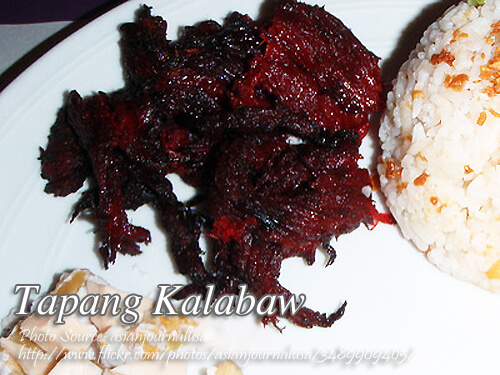

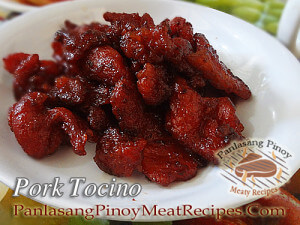
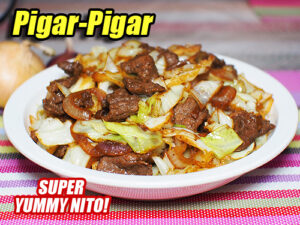
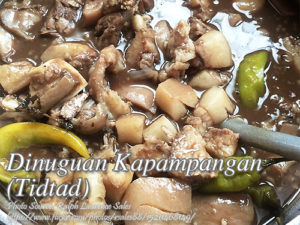
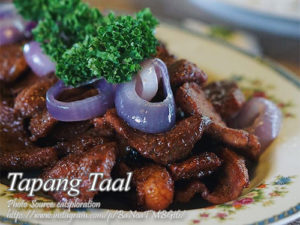
Tapang Kalabaw is not Pampanga delicacy only is the whole Central Luzon. In Bulacan we called it Pindang. Sir request sana ako ng recipe ng Serkele. Salamat
Hi Dan,
I hope someone can share the Serkele recipe. I think the recipe is a trade secret. I made a little research and found out it is from Bulacan.